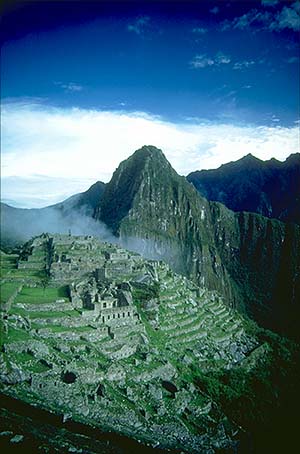
Machu Picchu (Quechua: Machu Picchu, "Old mountain") is a pre-Columbian Inca site located 2,400 meters (7,875 ft) above sea level. It is situated on a mountain ridge above the Urubamba Valley in Peru, which is 80 km (50 mi) northwest of Cusco. Often referred to as "The Lost City of the Incas", Machu Picchu is probably the most familiar symbol of the Inca Empire.
It was built around the year 1450, but abandoned a hundred years later, at the time of the Spanish conquest of the Inca Empire. Forgotten for centuries, the site was brought to worldwide attention in 1911 by Hiram Bingham, an American historian. Since then, Machu Picchu has become an important tourist attraction. It has recently come to light that the site may have been discovered and raided several years previously, in 1867 by a German businessman, Augusto Berns. It was declared a Peruvian Historical Sanctuary in 1981 and a UNESCO World Heritage Site in 1983. It is also one of the New Seven Wonders of the World.
Machu Picchu was built in the classical Inca style, with polished dry-stone walls. Its primary buildings are the Intihuatana, the Temple of the Sun, and the Room of the Three Windows. These are located in what is known by archaeologists as the Sacred District of Machu Picchu. In September of 2007, Peru and Yale University reached an agreement regarding the return of artifacts which Hiram Bingham had removed from Machu Picchu in the early 20th century. Currently, there are concerns about the impact of tourism on the site as it reached 400,000 visitors in 2003.
Machu Picchu was constructed around 1460, at the height of the Inca Empire. It was abandoned less than 100 years later. It is likely that most of its inhabitants were wiped out by smallpox before the Spanish conquistadores arrived. Hiram Bingham, the credited discoverer of the site, along with several others, originally hypothesized that the citadel was the traditional birthplace of the Inca people or the spiritual center of the "Virgins of the Suns".
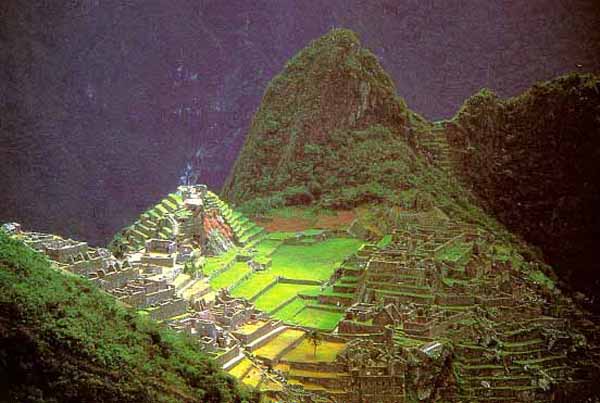
Another theory maintains that Machu Picchu was Inca "llacta": a settlement built to control the economy of the conquered regions. It may also have been built as a prison for a select few who had committed heinous crimes against Inca society. Research conducted by scholars, such as John Rowe and Richard Burger, has convinced most archaeologists that rather than a defensive retreat, Machu Picchu was an estate of the Inca emperor, Pachacuti. In addition, Johan Reinhard presented evidence that the site was selected based on its position relative to sacred landscape features. One such example is its mountains, which are purported to be in alignment with key astronomical events.
Although the citadel is located only about 80 kilometers (50 miles) from Cusco, the Inca capital, it was never found and consequently not plundered and destroyed by the Spanish, as was the case with many other Inca sites. Over the centuries, the surrounding jungle grew over the site, and few knew of its existence.
On July 24, 1911, Machu Picchu was brought to the attention of scholars by Hiram Bingham, an American historian then employed as a lecturer at Yale University. He was led there by locals who frequented the site. Bingham undertook archaeological studies and completed a survey of the area. Bingham coined the name "The Lost City of the Incas", which was the title of his first book. He never gave any credit to those who led him to Machu Picchu, mentioning only "local rumor" as his guide.
Bingham had been searching for the city of Vitcos, the last Inca refuge and spot of resistance during the Spanish conquest of Peru. In 1911, after years of previous trips and explorations around the zone, he was led to the citadel by Quechuans. These people were living in Machu Picchu, in the original Inca infrastructure. Even though most of the original inhabitants had died within a century of the city's construction, a small number of families survived so by the time the site was 'discovered' in 1911, there were still mummies (mostly women) in Machu Picchu and some families still living on the site. Bingham made several more trips and conducted excavations on the site through 1915. He wrote a number of books and articles about the discovery of Machu Picchu in his lifetime.
Simone Waisbard, a long-time researcher of Cusco, claims that Enrique Palma, Gabino Sánchez, and Agustín Lizárraga left their names engraved on one of the rocks at Machu Picchu on July 14, 1901. This would mean that they 'discovered' it long before Bingham did in 1911. Likewise, in 1904, an engineer named Franklin supposedly spotted the ruins from a distant mountain. He told Thomas Paine, an English Plymouth Brethren Christian missionary living in the region, about the site, Paine's family members claim. In 1906, Paine and another fellow missionary named Stuart E McNairn (18671956) supposedly climbed up to the ruins.
In 1913, the site received significant publicity after the National Geographic Society devoted their entire April issue to Machu Picchu. In 1981 an area of 325.92 square kilometers surrounding Machu Picchu was declared a "Historical Sanctuary" of Peru. In addition to the ruins, this area includes a large portion of the regional landscape, rich with flora and fauna.
Machu Picchu was designated as a World Heritage Site in 1983 when it was described as "an absolute masterpiece of architecture and a unique testimony to the Inca civilization". On July 7, 2007, Machu Picchu was voted as one of New Open World Corporation's New Seven Wonders of the World. As a result of environmental degradation resulting from the impacts of tourism, uncontrolled development in the nearby town of Aguas Calientes (including a poorly-sited tram to ease visitor access), and the construction of a bridge across the Vilcanota River in defiance of a court order and government protests (which would most likely bring even more tourists to the site), the World Monuments Fund placed Machu Picchu on its 2008 Watch List of the 100 Most Endangered Sites in the world.
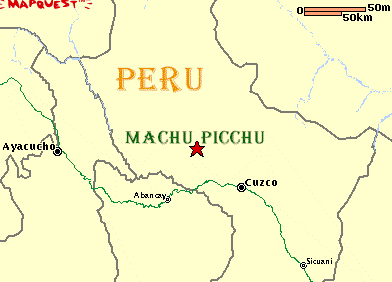
Machu Picchu is 70 kilometers northwest of Cusco, on the crest of the mountain Machu Picchu, located about 2,350 meters (7,710 ft) above sea level. It is one of the most important archaeological centers in South America and the most visited tourist attraction in Peru.
From the top, at the cliff of Machu Picchu, there is a vertical rock face of 600 meters ending at the foot of the Urubamba River. The location of the city was a military secret because its deep precipices and mountains were an excellent natural defense. The Inca Bridge, an Inca rope bridge across the Urubamba River in the Pongo de Mainique, provided a secret entrance for the Inca army. Another Inca bridge to the west of Machu Picchu, the trunk bridge, has a section across a cliff face with a 6 metres (20 ft) gap in it which could be bridged by two tree trunks. If the trees were removed, it would leave a 570 metres (1,900 ft) fall to the base of the cliffs to discourage invaders. It is above Urubamba Valley.
The city sits in a saddle between two mountains, with a commanding view down two valleys and a nearly impassable mountain at its back. It has a water supply from springs that cannot easily be blocked, and enough land to grow food for about four times as many people as actually lived there. The hillsides leading to it have been terraced, not only to provide more farmland to grow crops, but to steepen the slopes which invaders would have to ascend. There are two high-altitude routes from Machu Picchu across the mountains back to Cuzco, one through the sun gate, and the other across the Inca bridge. Both could easily be blocked if invaders should approach along them. Regardless of its ultimate purpose, it is in a highly defendable position.
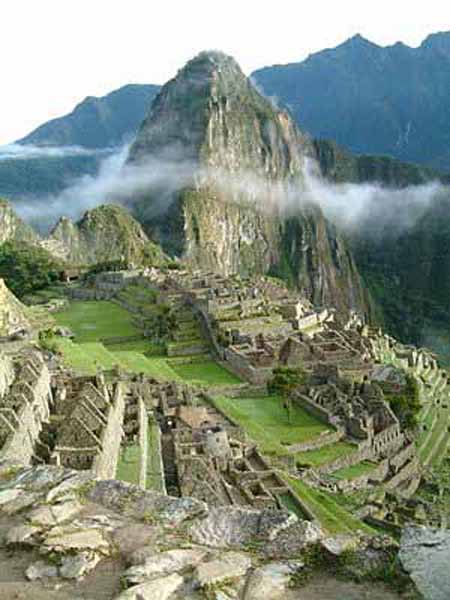
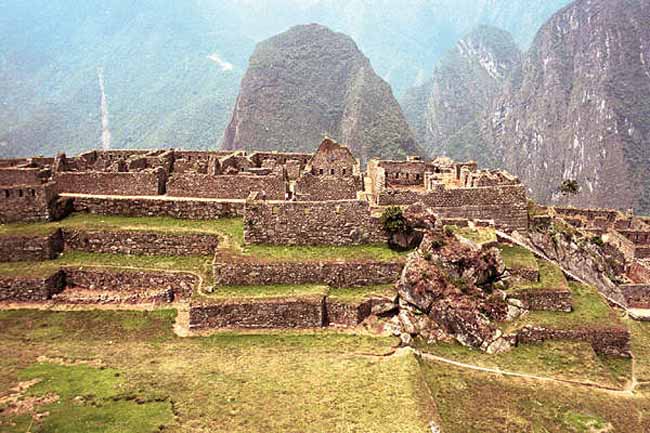
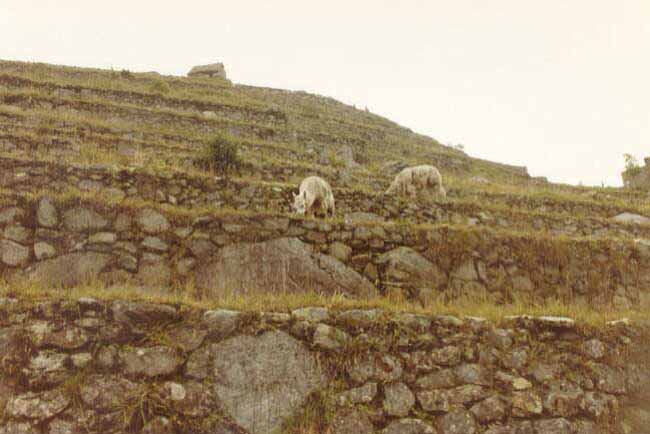
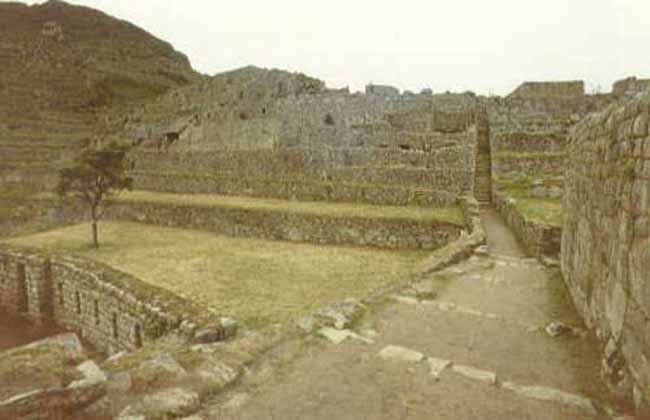
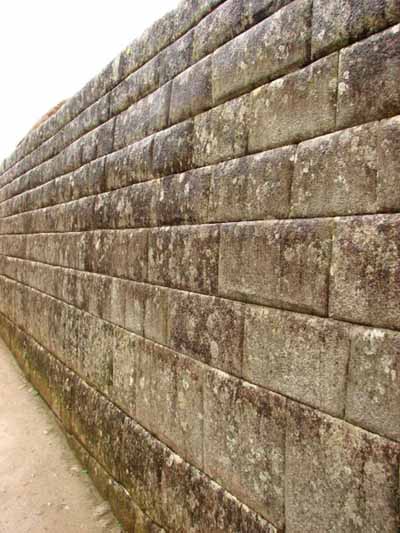
Most of the construction in Machu Picchu uses the classic Inca architectural style of polished dry-stone walls of regular shape. The Incas were masters of this technique, called ashlar, in which blocks of stone are cut to fit together tightly without mortar. The Incas were among the best stone masons the world has seen, and many junctions in the central city are so perfect that not even a knife fits between the stones.
Other Inca buildings have been built using mortar, but by Inca standards that was quick, shoddy construction. Peru is a highly seismic land, and mortar-free construction was more earthquake-resistant than using mortar. Inca walls show numerous subtle design details that would prevent them from collapsing in an earthquake.
Doors and windows are trapezoidal and tilt inward from bottom to top, corners are usually rounded, inside corners often incline slightly into the rooms, and "L" shaped blocks are often used to tie outside corners together. Walls do not rise straight from top to bottom but are offset slightly from row to row. As a result, Machu Picchu is a city that has stood up well to earthquakes over the years.
The Incas never used the wheel in any practical manner. How they moved and placed enormous blocks of stones is a mystery, although the general belief is that they used hundreds of men to push the stones up inclined planes. A few of the stones still have knobs on them that could have been used to lever them into position. After they were placed, the Incas would have sanded the knobs away.
The space is composed of 140 constructions including temples, sanctuaries, parks and residences (houses with thatched roofs). There are more than one hundred flights of stone steps - often completely carved from a single block of granite - and a great number of water fountains, interconnected by channels and water-drainages perforated in the rock, designed for the original irrigation system. Evidence has been found to suggest that the irrigation system was used to carry water from a holy spring to each of the houses in turn.
According to archaeologists, the urban sector of Machu Picchu was divided into three great districts: the Sacred District, the Popular District, to the south, and the District of the Priests and the Nobility.
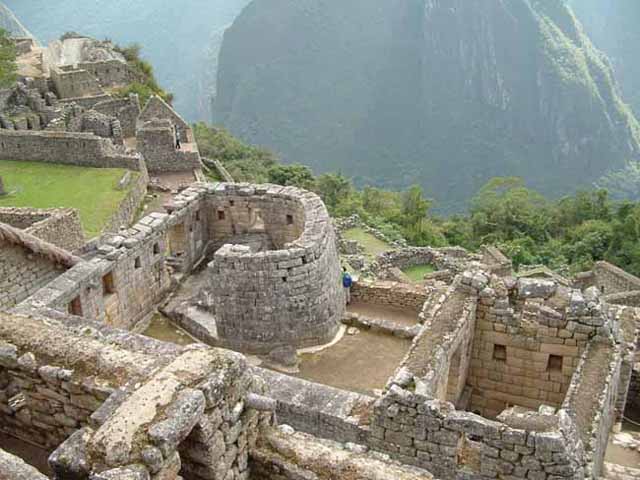
Located in the first zone are the primary archaeological treasures: the Intihuatana, the Temple of the Sun and the Room of the Three Windows. These were dedicated to Inti, their sun god and greatest deity. The Popular District, or Residential District, is the place where the lower class people lived. It includes storage buildings and simple houses to live in. In the royalty area, a sector existed for the nobility: a group of houses located in rows over a slope; the residence of the Amautas (wise persons) was characterized by its reddish walls, and the zone of the Nustas (princesses) had trapezoid-shaped rooms. The Monumental Mausoleum is a carved statue with a vaulted interior and carved drawings. It was used for rites or sacrifices.
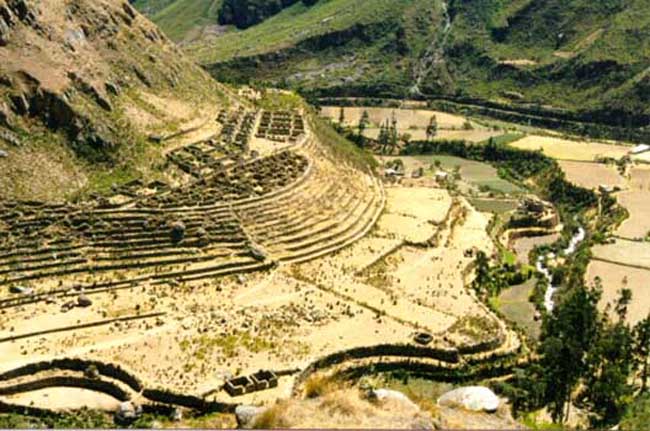
As part of their road system, the Inca built a road to Machu Picchu. Today, tens of thousands of tourists walk the Inca Trail to Machu Picchu each year, acclimatising at Cusco before starting on a two- to four-day journey on foot from the Urubamba valley up through the Andes mountain range.
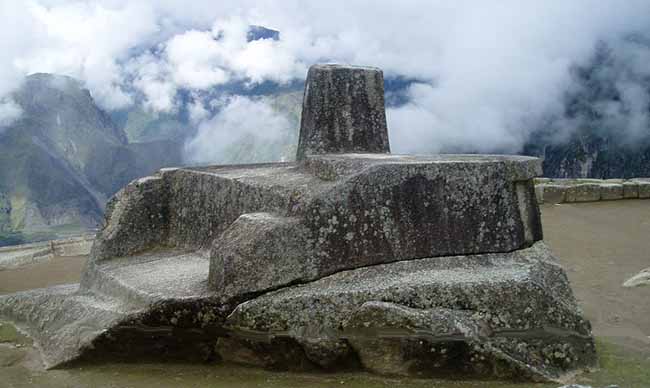
Shamanic legends say that if you're a sensitive person and you rub your forehead against the stone you will see the spirit world. The Intihuatana stone is one of the many ritual stones in South America. They are arranged so they point directly at the sun during the winter solstice.
The Spanish did not find Machu Picchu until the 20th century so the Intihuatana Stone was not destroyed like many other ritual stones. It is also called "The Hitching Point of the Sun" because it was supposed to hold the sun in its place.
At midday on March 21st and September 21st the sun stands almost above the pillar creating no shadow at all. It is (as they said before) believed to be an astronomic clock built by the Incas.
The Intihuatana Stone was damaged in September 2000 when a 450 kg (1,000-pound) crane fell onto it, breaking off a piece of stone the size of a ballpoint pen.
In the 1980s, a large rock from Machu Picchu's central plaza was moved to a different location in order to create a helicopter landing zone. Helicopter landings were forbidden in the 1990s. Reports circulated in February 2008 that a company, Helicusco, was able to make tourist flights over Machu Picchu, but the situation is unclear.
Machu Picchu is a UNESCO World Heritage site. As Peru¹s most visited tourist attraction and major revenue generator, it is continually threatened by economic and commercial forces. In the late 1990s, the Peruvian government granted concessions to allow the construction of a cable car to the ruins and development of a luxury hotel, including a tourist complex with boutiques and restaurants. These plans were met with protests from scientists, academics and the Peruvian public, worried that the greater numbers of visitors would pose tremendous physical burdens on the ruins.
A growing number of people visit Machu Picchu (400,000 in 2003[10]). For this reason, there were protests against a plan to build a further bridge to the site and a no-fly zone exists in the area. UNESCO is considering putting Machu Picchu on its list of endangered World Heritage Sites.
Machu Picchu's unusual patterns are best viewed from the sky. Some people believe it to be a landing strip for extraterrestrials, much like Peru's Nazca Lines. Its celestial observatory depicts many patterns found on petroglyphs throughout the world.
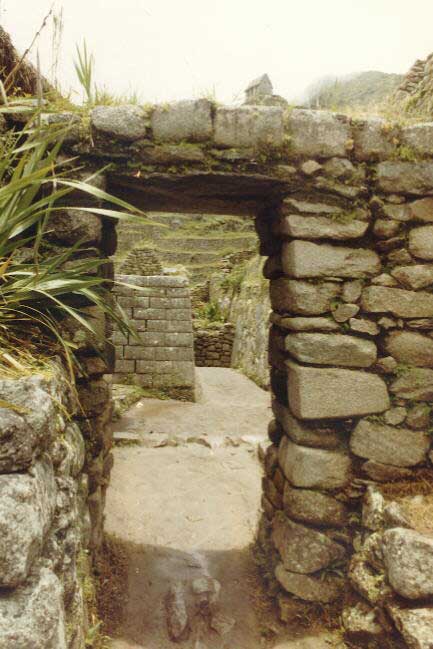




0 comments:
Post a Comment